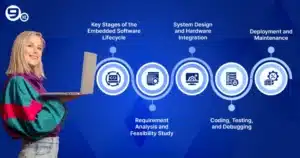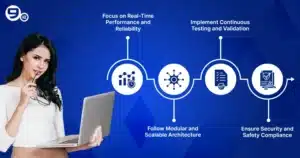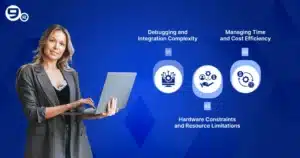A large portion of the technology around us is powered by embedded systems. From industrial controllers and automotive systems to medical equipment and home appliances, everything is powered by embedded systems. Every big embedded system has a software stack that needs to function dependably under pressure.
The methodical approach engineers use to manage embedded software systems is known as the Embedded Software Development Process. Well, delivering timely, high-quality, and secure embedded solutions depends heavily on an effective procedure.
This guide takes you through the entire embedded software development lifecycle, from key best practices to common challenges, along with the latest trends shaping the field.
What Is Embedded Software?
Software that is embedded is designed specially to be used on dedicated hardware systems that perform only a specific task. Nothing like general software, embedded software is built to work specifically on hardware only to ensure reliable performance.
- Runs on microcontrollers, microprocessors, or system-on-chips (SoCs) with limited CPU, memory, and power.
- Interfaces closely with hardware peripherals like sensors, actuators, communication modules, and interfaces (SPI, I²C, UART, CAN, etc.).
- Often has real-time constraints: deadlines must be met (hard or soft real-time).
- Needs to be robust, reliable, and operate over long lifecycles, sometimes in harsh environmental conditions.
- May run with no operating system, a real-time OS (RTOS), or a lightweight embedded operating system.
In short, embedded software is the intelligence inside devices that makes them responsive, autonomous, and functional in their target contexts.
Importance of Embedded
Why is embedded software so critical today?
- 1.Pervasiveness of “Smart” Devices
- 2. Real-Time Reliability
- 3. Resource-Constrained Environments
- 4. Long Life Cycles & Maintenance
The IoT, smart appliances, and medical instrumentation all rely heavily on embedded systems. Well, without this, these devices would be heavily unreliable.
Embedded systems interact with the physical world. Any sort of delays or failures might lead to catastrophic results. Embedded software must meet a behaviour that is deterministic.
Embedded systems have limited memory and processing power. It makes them pretty different than the PCs. Therefore, the software should be lean and optimized.
People have been using devices like medical machines and vehicles for decades. Therefore, the embedded software used in them should be designed for the long term. It makes them easy to maintain and upgrade time and time again.
Whenever any organization takes on such projects, they should only collaborate with reputed embedded software organizations. It helps them follow the best industry trends to reduce risks and bring their products to market faster.
Understanding the Embedded Software Development Process
The Embedded Software Development Process comprises a well-defined sequence of stages that transforms requirements into robust, deployable firmware or software. Below, we detail each stage and explain how they interrelate.
Key Stages of the Embedded Software Lifecycle
The lifecycle typically follows these major phases:
- Requirement Analysis and Feasibility Study
- System Design and Hardware Integration
- Coding, Testing, and Debugging
- Deployment and Maintenance
These stages often iterate in agile or incremental workflows, but the core flow remains consistent. Now let’s explore each in depth.
Requirement Analysis and Feasibility Study
This foundational stage involves:
- Gathering Requirements
- Defining Constraints
- Feasibility Study
- Risk Analysis & Mitigation
- Specification
Engage stakeholders (product owners, hardware engineers, end users) to collect functional, non-functional, performance, interface, safety, and security requirements.
Determine resource constraints: CPU cycles, memory (RAM, flash), I/O bandwidth, power budgets, temperature range, and communication protocols.
Under hardware constraints, assessments should be made about the requirements. Sometimes it must be optimized or trade-offs.
One should always be ready to identify any sort of technical failures and be willing to mitigate the plan.
Make a specification document about requirements that can deal with functionality, performance, and acceptance criteria.
This phase is critical. Any omission or misinterpretation here cascades downstream and becomes costly to fix later.
System Design and Hardware Integration
Once requirements are well understood and approved, the design phase begins:
- Architecture Design
- Hardware-Software Co-Design
- Interface Definition & Protocols
- Memory Map and Resource Allocation
- State Machine & Control Logic
- Safety, Fault Tolerance & Redundancy
- Simulation & Model Validation
Define high-level modules, interfaces, data flow, control flow, state machines, and partitioning between hardware, firmware, and software layers.
Work with hardware engineers to verify that the hardware platform (microcontroller, sensors, buses) supports the needed performance, interrupts, memory mapping, IO lines, power supply, clocks, etc.
Define how software interacts with peripherals (timers, ADCs, communication interfaces). Specify protocols and timing constraints.
Assign memory regions (bootloader, application, persistent storage). Allocate buffers, stacks, DMA channels, IO registers.
Design finite state machines or event-driven logic for handling system modes, fault conditions, and transitions.
For safety- or mission-critical systems, design watchdog timers, failsafe modes, recovery paths, error detection, and exception handling.
Optionally build software models or simulations (e.g., MATLAB/Simulink) or carry out hardware-in-the-loop (HIL) prototyping to validate the architecture before writing production code.
At the end of this stage, the design should be reviewed and approved, with clear interface contracts and design documents in place.
Coding, Testing, and Debugging
This is where the rubber meets the road: writing embedded software that implements features, meets performance goals, and is thoroughly validated.
- Coding / Implementation
- Unit Testing
- Integration Testing
- Hardware Testing & Bring-Up
- Debugging Tools
- Performance Optimization
- Regression Testing
- Static and Dynamic Analysis
- Documentation & Comments
- Bootloader & Firmware Upgrades
- Verification & Validation (V&V)
- Certification & Safety Approvals
- Deployment & Roll-out
- Maintenance & Updates
- Support & Monitoring
- Decommission or Phasing Out
Developers write modular, optimized code in selected programming languages (C, C++, occasionally embedded Python or Rust). Adhere to coding standards (MISRA, CERT, company-specific guidelines) to maximize safety, readability, and maintainability.
Developers write unit tests for each software module in isolation (e.g., mocking hardware interfaces). Use frameworks or custom test harnesses.
Integrate modules and test interactions, ensuring interfaces align and system-level logic works correctly.
Deploy onto actual hardware (prototype boards) to test against real peripherals. Validate interrupts, timing constraints, communication protocols, and edge-case behavior.
Use hardware debuggers (JTAG, SWD), trace tools (ETM, ITM), logic analyzers, oscilloscopes, and protocol analyzers to diagnose low-level failures, timing violations, memory corruption, or resource issues.
CPU cycle, memory, interrupt latency, and power profiling. Optimize the critical paths (e.g., ISR code, DMA, buffer management), eliminate bottlenecks, and reduce memory footprint.
Well, whenever introducing new changes, execute a regression test suite so the current behavior is not impacted.
Employ static code analyzers (linting, MISRA checks) and dynamic tools (memory checkers, sanitizers) to detect buffer overflows, memory leaks, undefined behavior, and concurrency bugs.
Document module interfaces, APIs, state machines, configuration parameters, error codes, and assumptions. Good documentation is extremely important for maintainability.
Take a Look…
Top 10 Benefits of Custom Software Development for Businesses in 2025
Deployment and Maintenance
After the system has gone through test and review, it progresses towards deployment:
Provide a robust bootloader or update mechanism to support over-the-air (OTA) updates or in-field reflashing while still delivering fallback safety.
Do acceptance testing, system-level testing under all circumstances, stress testing, environmental testing (temperature, vibration, electromagnetic interference), and compliance testing.
In regulated environments (automotive, medical, aerospace), obtain required safety certifications (e.g., ISO 26262, IEC 62304, DO-178) by providing required traceability, documentation, and test evidence.
Push firmware onto production hardware, monitor performance in the field, collect logs and telemetry, and verify proper operation.
Over time, fix bugs, close vulnerabilities, introduce features, and push updates via OTA or servicing. Further, handle version control, regression testing, and open release management.
Put in place remote diagnostics, error tracking, crash dumps, logging, and health monitoring mechanisms to enable support and proactive maintenance.
Develop end-of-life strategies, notify users, provide migration routes, and responsibly archive source artifacts.
Throughout deployment and maintenance, an embedded software development provider of embedded software development services plays a key role in ensuring long-term reliability, updates, and compliance.
Start Your Embedded Software Development Project
Talk to our Experts
Request A Free Quote
Tools and Technologies Used in Embedded Software Development
Embedded development requires a sophisticated toolchain combining programming languages, operating systems/RTOS, development environments, and hardware debugging tools.
Popular Programming Languages (C, C++, Python, etc.)
- C
- C++
- Python / MicroPython / CircuitPython
- Rust
- Hardware Description Languages (HDL: VHDL, Verilog)
The lingua franca of embedded systems, C, is ubiquitous due to its low-level access, deterministic behavior, minimal overhead, and portability.
Widely adopted for higher abstraction, object-oriented design, and safer constructs (templates, RAII). However, care must be taken to avoid dynamic memory and complex features on constrained targets.
Used in higher-level or prototyping scenarios, particularly on resource-rich microcontrollers (e.g., ESP32, STM32 with ample RAM). Useful for scripting, testing, interpreters, or higher-level control.
Emerging in embedded for its safety guarantees (memory safety, concurrency safety) without garbage collection. Suitable for building reliable firmware in safety-critical systems.
Though not strictly software, for systems involving programmable logic (FPGA/PLD), HDL is used to define hardware-level behavior.
Embedded Operating Systems and IDEs
- Real-Time Operating Systems (RTOS)
- Bare-Metal (No OS)
- Embedded Linux
Common choices include FreeRTOS, Zephyr, RTEMS, ThreadX, µC/OS, and commercial options like QNX. These support task scheduling, inter-task communication, timers, memory management, and priority control.
In ultra-constrained systems, no RTOS is used; the firmware manually handles state machines and scheduling.
For more capable SoCs, embedded Linux (Yocto, Buildroot) is used to provide rich ecosystems with drivers, filesystems, networking, and user-space applications.
- Integrated Development Environments (IDEs) / Toolchains
- Vendor-provided IDEs: e.g., STM32CubeIDE, MPLAB X, NXP MCUXpresso, TI Code Composer.
- Eclipse-based or VS Code: with extensions (GDB, OpenOCD, Cortex-Debug).
- GNU Toolchain: GCC (arm-none-eabi), binutils, Make/CMake, linker scripts.
- Build Systems & Continuous Integration
Tools like CMake, Makefiles, Bazel, and CI pipelines (Jenkins, GitHub Actions) enforce consistent builds and automated tests.
Hardware Simulation and Debugging Tools
- Simulators / Emulators
- Hardware-in-the-Loop (HIL)
- In-Circuit Debuggers / Programmers
Virtualize microcontrollers or peripherals (e.g., QEMU, vendor simulators) for early-stage testing before hardware is ready.
Combine real hardware with simulated peripheral components to verify correctness in near-real environments.
Tools like JTAG, SWD, BDM, and ICE that allow stepping through code, setting breakpoints, reading/writing memory/registers, single-stepping, and tracing.
- Trace & Profiling Tools
- Instruction trace (ETM, PTM, ITM) to capture executed instruction sequences.
- Logic analyzers / Oscilloscopes to capture signals, bus transactions, and timing.
- Protocol analyzers (I²C, SPI, CAN, UART analyzers) to decode bus communications.
- Power analyzers / Monitoring to observe energy usage over time and profile peaks.
- Memory Analyzers & Debug Tools
- Version Control & DevOps Tools
Monitor heap, stack usage, detect memory corruption, buffer overruns.
Git, SVN, GitLab, Jira, issue tracking, documentation systems, code reviews, traceability tools (for safety compliance).
By combining these tools and techniques, an Embedded Software Development Company or provider of embedded software development services can manage complexity and deliver robust systems.
Best Practices for Successful Embedded Software Development
To execute a reliable and maintainable Embedded Software Development Process, firms and engineers should follow these best practices:
Focus on Real-Time Performance and Reliability
- Prioritize Determinism
- Bounded Execution Times
- Avoid Dynamic Allocation in Time-Critical Paths
- Watchdog and Health Monitoring
- Graceful Failure Handling
- Separation of Concerns
- Layered Design
- Interface Contracts
- Configurable Modules
- Plug-in / Driver Frameworks
Real-time deadlines (hard or soft) must be met. Use priority-based scheduling, avoid unbounded blocking, and ensure interrupt latency is within acceptable bounds.
Analyze worst-case execution times (WCET) for critical tasks and verify that timing margins exist.
Use static memory, memory pools, and preallocated buffers rather than malloc/free in an interrupt context.
Use watchdog timers to detect stalls, implement self-tests, heartbeats, and fault recovery strategies.
Design fallback modes, safe shutdown, and failover paths in case of sensor failure or communication loss.
Follow Modular and Scalable Architecture
Divide the system into independent modules (drivers, middleware, application logic) with well-defined interfaces to reduce coupling.
Establish clear layering—HAL (Hardware Abstraction Layer), drivers, middleware, application—to support portability and scalability.
Define API contracts, versioning, and error codes to avoid hidden dependencies.
Use compile-time or run-time configuration to enable/disable features, adapt to multiple hardware variants, or scale product lines.
Adopt plugin architectures or dynamic loading (if feasible) to support modular extensibility.
Start Your Embedded Software Development Project
Talk to our Experts
Request A Free Quote
Implement Continuous Testing and Validation
- Automate Testing
- Hardware Abstraction for Testability
- Test Early & Often
- Code Coverage & Metrics
- Continuous Integration / Continuous Delivery (CI/CD)
- Regression Safeguards
- Secure by Design
- Input Validation & Safe Interfaces
- Authentication & Encryption
- Integrity & Anti-Tamper Features
- Safety Standards Compliance
- Vulnerability Monitoring & Patching
Build unit tests, integration tests, system tests, and regression suites, and include them in CI pipelines.
Utilize mock or stub layers over hardware interfaces to execute tests without physical target boards.
Move testing left: execute validation as early in the development process as feasible to identify defects early.
Maintain a minimum threshold and quantify coverage. Track static analysis and code complexity.
Employ pipelines and build servers to build firmware and deliver production binaries.
Attempt regression tests prior to handling new firmware to prevent any issues.
Guarantee Security and Safety Compliance
Include threat modeling, secure boot, encryption (flash, communications), access control, and secure update mechanisms.
Validate all inputs, sanitize data, prevent buffer overflows, use bounds checking, and employ safe APIs.
Employ secure cryptographic primitives for bootloaders, firmware updates, over-the-air, and data encryption
Employ code signing, checksums, hardware security modules (HSM), and secure enclaves (e.g., TrustZone) where they exist.
In regions of regulation, ensure traceability from requirements to test, perform hazard analysis, ensure redundancy, and adhere to standards (ISO 26262, IEC 61508, MISRA guidelines, etc.).
Track new security threats and give timely fixes. Give rollback and recovery safely.
Also Have a Look…
How Much Does Software Development Cost in 2025?
By following these practices, an Embedded Software Development Company or embedded software development team offering embedded software development services enhances the quality, reliability, safety, and maintainability of a product.
Common Challenges in Embedded Software Projects
Despite careful planning, embedded projects often face unique challenges. Understanding them helps mitigate risk early.
Hardware Constraints and Resource Limitations
- Limited CPU, Memory, and Storage
- Power & Energy Constraints
- Timing & Latency Constraints
- Peripherals & Electrical Noise
- Hardware Variants & Changes
There is rarely excess headroom. Engineers must optimize code, manage memory carefully, and choose efficient algorithms.
Battery-powered or energy-harvesting systems require energy-efficient design (sleep modes, duty cycling).
High-speed I/O or sensor sampling may require tight timing adherence. Jitter or latency can break control loops.
Analog/digital noise, signal integrity, ADC behavior, power line noise, EMI, thermal effects—all can hamper reliable operation.
Board revisions, different chip variants, and supplier changes may force software adaptation across variants.
Debugging and Integration Complexity
- Hard-to-Reproduce Failures
- Concurrent & Real-Time Issues
- Integration with Third-Party Components
- Limited Visibility
- Hardware-Software Co-Dependencies
- Scope Creep & Changing Requirements
- Cost Pressures
- Long Development Cycles
- Hiring Specialized Talent
- Maintenance Overheads
Rare timing races, memory corruption, or intermittent faults might appear only under particular conditions, making reproduction hard.
Interrupts, DMA, concurrent tasks, and resource contention can create deadlocks, priority inversion, and race conditions.
Legacy drivers, proprietary IP, or third-party firmware may require adaptation and detailed integration.
Embedded systems often lack rich observability; tracing, logging, or introspection is harder than in desktop environments.
A software bug might be triggered only with specific hardware configuration, which complicates debugging.
Managing Time and Cost Efficiency
Requirements often evolve, which may clash with hardware constraints or schedule.
Embedded projects often have tight budgets; overspending on prototypes or rework is risky.
Embedded design cycles may be longer due to hardware dependency, certification, or regulatory steps.
Skilled embedded engineers are less common; recruiting, training, and retaining them is costly.
Legacy code, supporting multiple hardware versions, and providing OTA updates add ongoing cost.
To navigate these challenges, many firms rely on an experienced Embedded Software Development Company to supplement internal capabilities and reduce risk.
Future Trends in Embedded Software Development
Embedded systems are continuing to evolve rapidly. Here are some emerging trends shaping the future of the Embedded Software Development Process.
Role of AI and Machine Learning in Embedded Systems
- On-Device Inference & TinyML
- Adaptive & Intelligent Behavior
- Predictive Maintenance
- Autonomy & Edge AI
Machine learning models are increasingly being deployed on microcontrollers (TinyML) to enable local decision-making (e.g., classification, anomaly detection) without relying on the cloud.
Embedded systems can adapt in real time using online learning or reinforcement techniques to improve performance or adjust to changing conditions.
Embedded devices will monitor their own health, predict failures, and schedule maintenance proactively.
Drones, robots, and autonomous vehicles will rely on embedded ML pipelines combined with sensor fusion locally.
IoT Integration and Edge Computing
- Edge Intelligence
- Distributed Systems & Fog Architectures
- Interoperability & Connectivity
- Security & Privacy at the Edge
- Ultra-Low-Power Designs
- Deterministic Real-Time Architectures
- Hardware Acceleration & Domain-Specific Accelerators
- Formal Methods & Verified Software
- Standardized Middleware & Open Platforms
More computation is pushed from the cloud to the edge to reduce latency, bandwidth use, and improve reliability.
Embedded devices will participate in hierarchical compute clusters from edge to fog to cloud.
Protocols like MQTT, CoAP, LwM2M, OPC UA, and standardized IoT stacks will be more pervasive.
Privacy-preserving compute (homomorphic encryption, federated learning) will be integrated into embedded stacks.
Advancements in Low-Power and Real-Time Systems
New microcontrollers, energy-harvesting techniques, and efficient sleep modes push battery life further.
Improved RTOS, hardware accelerators, time-triggered architectures, and real-time networks (TSN) will strengthen determinism.
FPGAs, ASICs, and AI accelerators (like NPUs) will offload compute-heavy tasks from main firmware loops.
Formal verification, model checking, and static proofs will gain traction, especially in safety-critical embedded systems.
Open-source frameworks (e.g., Zephyr, ROS 2 on embedded platforms) will streamline development and foster community collaboration.
As these trends progress, the Embedded Software Development Process evolves in parallel. Companies offering embedded software development services must adopt new toolchains, security paradigms, and architectures. An adaptive Embedded Software Development Company that embraces AI, IoT, low-power design, and real-time innovations will remain competitive and future-ready.
Conclusion
The Embedded Software Development Process is a disciplined, multi-stage approach that transforms requirements into reliable, efficient, and deployable embedded systems. From requirement analysis to design, coding, deployment, and maintenance, each phase demands rigorous practices, tools, and expertise.
Many organizations partner with an Embedded Software Development Company or engage embedded software development services to handle complexity, reduce risk, and accelerate time-to-market. By adhering to best practices—focusing on real-time performance, modular architectures, continuous testing, security, and compliance—and by being aware of common challenges (hardware constraints, debugging complexity, time and cost pressures), development teams can deliver robust embedded systems.
Finally, as AI, IoT, edge computing, and low-power methods continue to advance, the future of embedded software is rich with possibilities. Embracing these trends and integrating them into your process will ensure that your embedded solutions remain reliable, scalable, and competitive in the years ahead.












